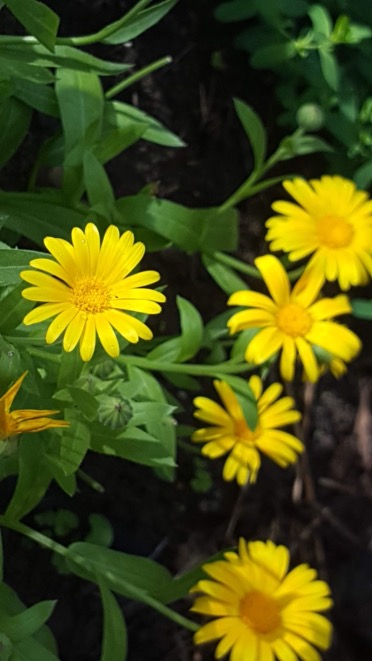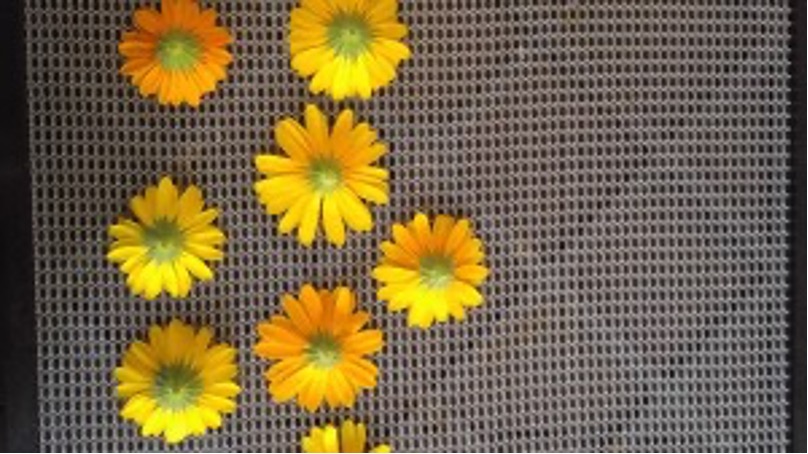BY AUDRAY PEPIN
JULY 9, 2024
COMMENT 1
Calendula (Calendula officinalis), also known as pot marigold or common marigold, is a first-choice plant for cuts, burns, scrapes, insect bites and other minor problems, because it works on three levels. It disinfects, calms inflammation (which, to a certain extent, also reduces pain) and stimulates regeneration of damaged cells (thus encouraging healing).

Calendula is an annual plant, easy to start from seed. It is also very floriferous, flowering from the end of June, at least here in Montreal, until the first frosts (and even a little after), almost always in shades of more or less dark orange-yellow. It’s a very pretty medicinal plant that won’t give you any trouble.
You’ll also find several cultivars. Normally, these are used in the same way. I’m particularly fond of ‘Calypso’, which is deep orange in color, with a flower head rich in the sought-after sticky resin. Personally, I have reservations about the paler or pinkish cultivars (probably less rich in carotenoids). They don’t seem to be as effective at promoting healing, but are nonetheless very pretty in the garden.
As for the name “marigold”, it derives from Solsequia, meaning “that follows the sun”. Note, however, that several Asteraceae, including sunflowers, chicory and dandelion, have flower heads that follow the movement of the sun (well, the sun’s light).
“The marigold goes to bed with the sun and with him rises, weeping“, Shakespeare (Winter’s Tale)
In Greek mythology, this phenomenon is explained by the fact that the marigold was originally a wood nymph who fell madly in love with Apollo, the sun god, provoking the fury of Artemis. Artemis transformed the nymph into a white marigold. Apollo couldn’t save the nymph, but his rays gave her her superb yellow-orange color. And ever since, the nymph, still in love with Apollo, turns her head towards the sun every day.
The name calendula comes from the Latin calandæ (“as the months go by”), due to its very long flowering period. In warmer climates, calendula blooms all year round. In Canada, this hardy plant is one of the last to continue flowering into autumn.
As for the name “marigold”, it derives from Solsequia, meaning “that follows the sun”. Note, however, that several Asteraceae, including sunflowers, chicory and dandelion, have flower heads that follow the movement of the sun (well, the sun’s light).
“The marigold goes to bed with the sun and with him rises, weeping“, Shakespeare (Winter’s Tale)
In Greek mythology, this phenomenon is explained by the fact that the marigold was originally a wood nymph who fell madly in love with Apollo, the sun god, provoking the fury of Artemis. Artemis transformed the nymph into a white marigold. Apollo couldn’t save the nymph, but his rays gave her her superb yellow-orange color. And ever since, the nymph, still in love with Apollo, turns her head towards the sun every day.
If you manage to dislodge your gaze from the flowers, you’ll find a hairy texture on the rest of the aerial parts, with alternate leaves around 7 to 8 cm (4″) long.
 Calendula flower heads.
Calendula flower heads.
JULY 9, 2024
COMMENT 1
Calendula (Calendula officinalis), also known as pot marigold or common marigold, is a first-choice plant for cuts, burns, scrapes, insect bites and other minor problems, because it works on three levels. It disinfects, calms inflammation (which, to a certain extent, also reduces pain) and stimulates regeneration of damaged cells (thus encouraging healing).

Astonishing Results
I’ve lost count of the feedback I’ve received, in which someone said they were amazed at how quickly the improvement became visible. Or the comparative tests where the natural product was used on one finger and the drugstore product on the other, and where the calendula demonstrated its superiority.Calendula is an annual plant, easy to start from seed. It is also very floriferous, flowering from the end of June, at least here in Montreal, until the first frosts (and even a little after), almost always in shades of more or less dark orange-yellow. It’s a very pretty medicinal plant that won’t give you any trouble.
You’ll also find several cultivars. Normally, these are used in the same way. I’m particularly fond of ‘Calypso’, which is deep orange in color, with a flower head rich in the sought-after sticky resin. Personally, I have reservations about the paler or pinkish cultivars (probably less rich in carotenoids). They don’t seem to be as effective at promoting healing, but are nonetheless very pretty in the garden.
The Calendula
The name calendula comes from the Latin calandæ (“as the months go by”), due to its very long flowering period. In warmer climates, calendula blooms all year round. In Canada, this hardy plant is one of the last to continue flowering into autumn.As for the name “marigold”, it derives from Solsequia, meaning “that follows the sun”. Note, however, that several Asteraceae, including sunflowers, chicory and dandelion, have flower heads that follow the movement of the sun (well, the sun’s light).
“The marigold goes to bed with the sun and with him rises, weeping“, Shakespeare (Winter’s Tale)
In Greek mythology, this phenomenon is explained by the fact that the marigold was originally a wood nymph who fell madly in love with Apollo, the sun god, provoking the fury of Artemis. Artemis transformed the nymph into a white marigold. Apollo couldn’t save the nymph, but his rays gave her her superb yellow-orange color. And ever since, the nymph, still in love with Apollo, turns her head towards the sun every day.
The name calendula comes from the Latin calandæ (“as the months go by”), due to its very long flowering period. In warmer climates, calendula blooms all year round. In Canada, this hardy plant is one of the last to continue flowering into autumn.
As for the name “marigold”, it derives from Solsequia, meaning “that follows the sun”. Note, however, that several Asteraceae, including sunflowers, chicory and dandelion, have flower heads that follow the movement of the sun (well, the sun’s light).
“The marigold goes to bed with the sun and with him rises, weeping“, Shakespeare (Winter’s Tale)
In Greek mythology, this phenomenon is explained by the fact that the marigold was originally a wood nymph who fell madly in love with Apollo, the sun god, provoking the fury of Artemis. Artemis transformed the nymph into a white marigold. Apollo couldn’t save the nymph, but his rays gave her her superb yellow-orange color. And ever since, the nymph, still in love with Apollo, turns her head towards the sun every day.
If you manage to dislodge your gaze from the flowers, you’ll find a hairy texture on the rest of the aerial parts, with alternate leaves around 7 to 8 cm (4″) long.






